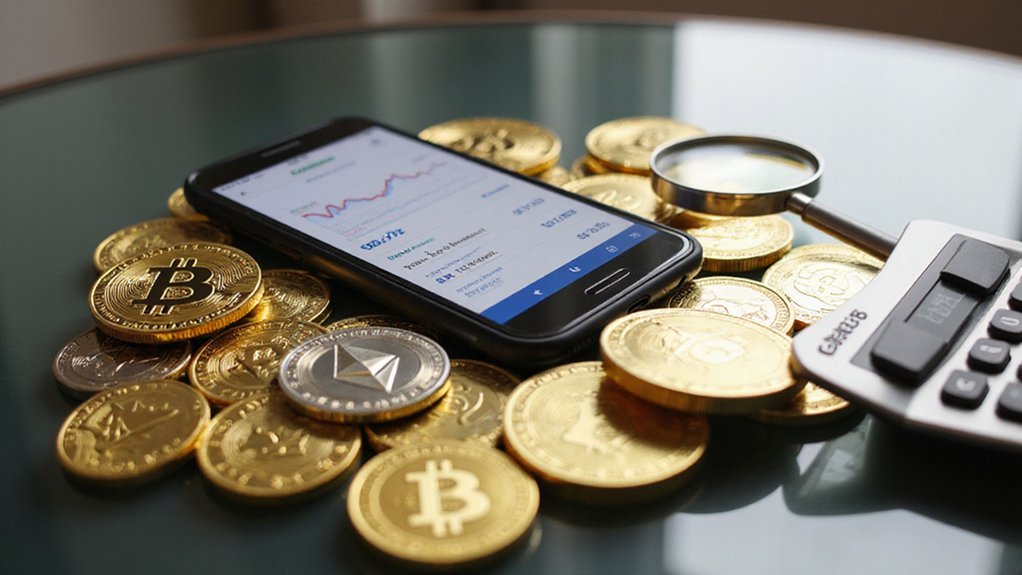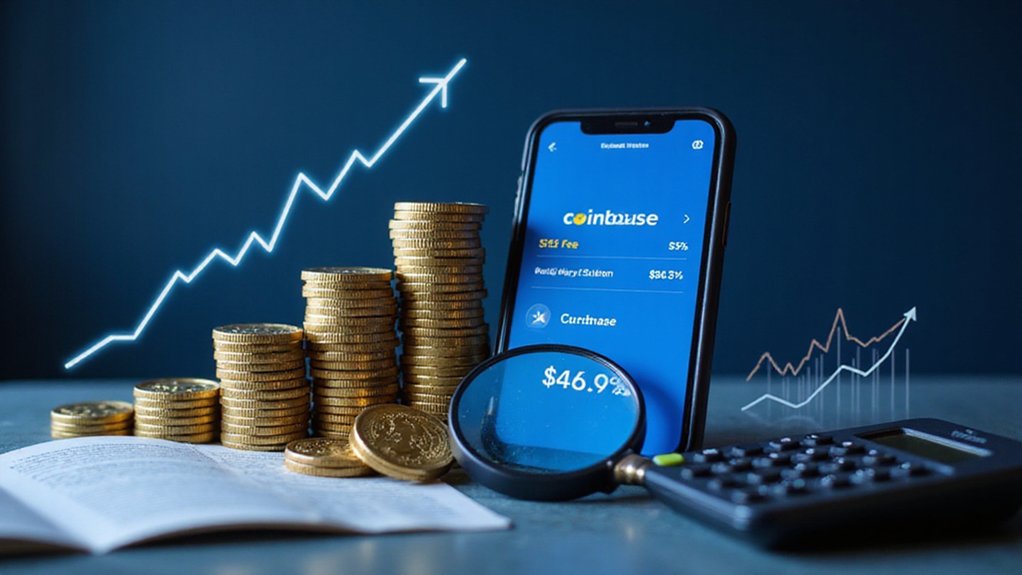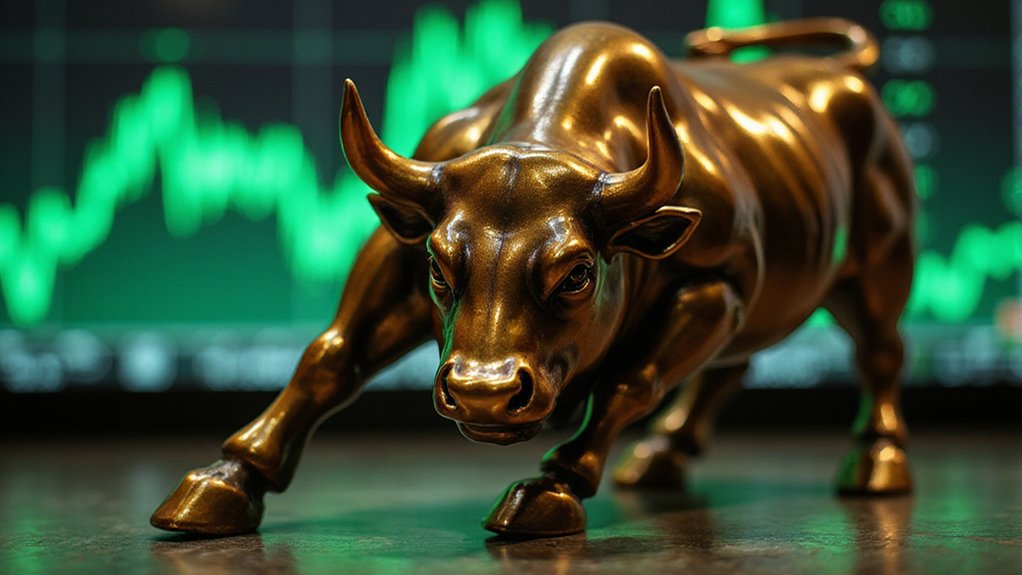Coinbase’s fee structure encompasses a range of costs that would make a tax attorney blush. Trading fees follow the maker-taker model (0.00%-0.40% for makers, 0.05%-0.60% for takers), while staking incurs commissions up to 35%. The Coinbase One subscription ($29.99 monthly) potentially offsets costs for frequent traders. Deposits via bank transfers cost nothing, but withdrawals—particularly wire transfers—command a princely $25 sum. The platform’s labyrinthine pricing reflects both market conditions and regulatory realities.

The labyrinthine fee structure of Coinbase—America’s largest cryptocurrency exchange by trading volume—presents a formidable challenge for both novice traders and seasoned investors attempting to navigate the platform’s financial ecosystem. Users encounter a diverse array of charges, from trading fees and transfer costs to staking commissions and blockchain levies, each with its own calculation methodology and triggering conditions.
At the core of Coinbase’s revenue model lies its trading fee schedule, structured around the maker-taker paradigm. Taker fees—applied when orders execute immediately at market price—range from 0.05% to a rather steep 0.60%, while maker fees for orders that patiently wait in the order book span from a merciful 0.00% to 0.40%. The platform also incorporates a spread (a subtle yet omnipresent cost factor) that fluctuates with market volatility.
Coinbase extracts its profit through the maker-taker mechanism, with fees reaching 0.60% amid the ever-present spread’s subtle toll.
Staking cryptocurrency through Coinbase appears initially benevolent with no direct fees for the act itself, yet the platform extracts its pound of flesh through commissions on earned rewards. These commissions—reaching as high as 35% for certain assets like ADA and ATOM—represent a substantial portion of passive income potential. (One might wonder if this commission rate would raise eyebrows in traditional finance circles.) When users stake their assets, they maintain full ownership rights but cannot transfer or trade their cryptocurrencies until the unstaking process completes, which varies by asset.
For those conducting frequent transactions, the Coinbase One subscription at $29.99 monthly presents a potential remedy to fee fatigue, offering reduced or waived trading costs. Whether this subscription proves economically advantageous depends entirely on one’s trading volume and frequency—a calculation worthy of one’s spreadsheet skills.
Deposits via bank transfers typically incur no fees, but withdrawals tell a different story, with wire transfers commanding a $25 premium. The platform generated $2.9 billion in revenue in 2023, highlighting the significant financial impact of its fee structure.
Additional blockchain network fees, which fluctuate based on network congestion, are passed directly to users.
Various factors—including transaction size, market conditions, trading frequency, and verification status—ultimately determine the final fee amounts.
These costs partially reflect Coinbase’s regulatory compliance obligations and security infrastructure maintenance, necessary components of institutional legitimacy in the crypto frontier.
Frequently Asked Questions
How Do Coinbase Fees Compare to Other Cryptocurrency Exchanges?
Coinbase’s fees typically run higher than competitors like Binance, with trading fees ranging from 0.05% to 0.60% versus Binance’s 0.07% to 0.10%.
While Coinbase charges $10 for wire deposits and $25 for withdrawals (ACH transfers remain mercifully free), Binance offers free wire transfers but variable cryptocurrency withdrawal fees.
Advanced traders might appreciate that both platforms offer fee reduction opportunities—Coinbase through activity-based discounts and Binance through BNB token utilization.
Can I Negotiate Lower Fees With Coinbase?
Negotiating lower fees with Coinbase isn’t an option—their structure remains stubbornly inflexible.
Unlike traditional financial institutions where relationship banking might yield concessions, Coinbase operates on a take-it-or-leave-it model with tiered rates based solely on trading volume.
Users seeking reduced costs must either amplify their trading activity to qualify for volume-based discounts or employ strategic maneuvers like limit orders and post-only trades—a peculiar paradigm where one must spend more to save more.
Do Fees Change During Cryptocurrency Market Volatility?
Cryptocurrency market volatility indeed influences Coinbase’s fee structures.
During turbulent periods—when even Bitcoin exhibits its notorious price gymnastics—the platform may adjust spreads and transaction costs accordingly.
This volatility-responsive pricing stems from heightened trading volumes, liquidity constraints, and risk management imperatives.
While base fees remain structured, the practical impact on traders manifests through wider spreads and potentially elevated processing charges—nature’s way of reminding investors that market chaos rarely comes without cost.
Are There Hidden Fees Not Listed in Coinbase’s Fee Schedule?
Technically, Coinbase doesn’t have “hidden” fees, but several charges exist beyond their standard fee schedule that customers frequently overlook.
The spread fee—embedded in cryptocurrency purchase/sale prices rather than explicitly listed—frequently surprises users.
Network gas fees, while not Coinbase profits, add considerable transaction costs.
Staking commissions (reaching 35% for certain tokens) operate as reward deductions rather than transparent fees.
Even the Coinbase One subscription excludes certain transaction types from its “zero-fee” promise.
How Often Does Coinbase Update Their Fee Structure?
Coinbase updates its fee structure on an irregular schedule, responding primarily to market conditions rather than following a predetermined timetable.
While substantial revisions have occurred with multi-year intervals (notably in October 2019 and September 2022), the platform reserves the right to adjust fees more frequently as needed.
All modifications are transparently communicated before implementation, with changes calculated based on trailing 30-day volume metrics—a system that helps stabilize tier calculations amid market volatility.









